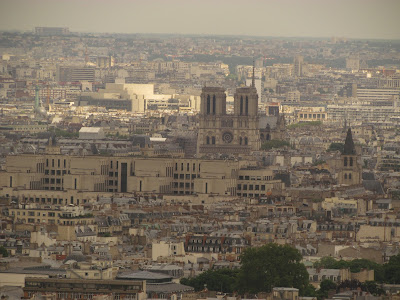EUROPE 2013
May saw us taking off on a trip to France, Belgium, England, Italy, Switzerland and Germany. You
can read about this here. There is a menu on the right hand side of
the page so you can choose which country you would like to read about.
We started out from Comox airport very early to Vancouver on Central Mountain Air, on to Montreal with Air Canada and finally on to Paris again with Air Canada. As you can see in the photo below the weather in Montreal wasn't much to write home about, dull and raining. The plane was one of the new Boeing 777's, very spacious, quiet and comfortable.
We puffed our way up to the second level and decided that was enough and, because of the crowds, we would forgo the elevator ride to the top. The view from where we were was impressive enough and the wait for the top was very long.
The Champ de Mars
We found our way back to the hostel on the Metro and had a nice dinner nearby. Early to bed because we had an early start again for the rail journey to Brussels and Bruges.
We started out from Comox airport very early to Vancouver on Central Mountain Air, on to Montreal with Air Canada and finally on to Paris again with Air Canada. As you can see in the photo below the weather in Montreal wasn't much to write home about, dull and raining. The plane was one of the new Boeing 777's, very spacious, quiet and comfortable.
Our 777 waiting for us Montreal Airport
You can see a larger version of any
photograph by simply clicking the mouse once on the image. Another click
outside the image returns you to the text
We
arrived at Charles De Gaulle airport early in the morning and took the
train to the Gare Du Nord. There we collected some railway tickets we
had bought on-line some three months earlier, the earlier you buy the
cheaper the tickets. The system is easy when you know what to do at the
ticket machine and we soon had our tickets for the journey to Brussels
and Bruges the next morning. We stayed at the same very good hostel we
had used before, within easy walking distance from the station and just
below the Sacre Coeur, which we could see just up the hill behind us.
We had the whole day ahead and we used the efficient Metro to get us
close to the Eiffel Tower. It was cold but not wet. As one might
expect for one of the major tourist attractions of Paris there were
plenty of tourists around. You can take an elevator or stairs to the
first level. The queue for the elevator was about 90 minutes long and
the wait for a stairs ticket just 30 minutes, so we joined that queue.
Part of the queue for tickets
We puffed our way up to the second level and decided that was enough and, because of the crowds, we would forgo the elevator ride to the top. The view from where we were was impressive enough and the wait for the top was very long.
The Sacre Coeur from the Eiffel Tower
Notre Dame
The River Seine
The Champ de Mars
We found our way back to the hostel on the Metro and had a nice dinner nearby. Early to bed because we had an early start again for the rail journey to Brussels and Bruges.







































